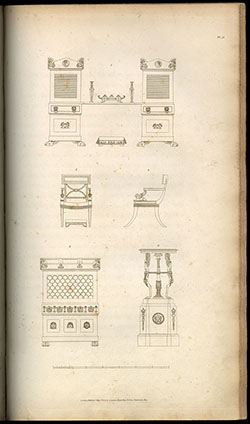
|
Thomas Hope, Household Furniture and Interior Decoration (London, 1807).
Influenced by his travels through Egypt, Greece, and Turkey, Hope designed and furnished his London estate inspired by antiquities. This volume, docu-menting the décor in the public rooms of his home, helped popularize Greek Revival and other classical styles. The Library Company acquired this book soon after its publication. |
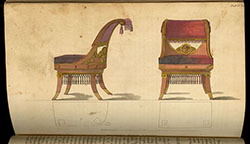 |
The Repository of Arts, Literature, Commerce, Manufactures, Fashions, and Politics, etc. (London: Rudolph Ackermann, December, 1809).
Shown here are richly carved, elegant mahogany chairs gilt in gold. “They may be covered with the best red morocco leather, velvet, or (which is far more elegant) rich damask silk, ornamented with rich Persian fringe…” Published by Rudolph Ackermann, this monthly magazine showcased interior decoration with vibrant color plates. Designs came from French and British craftsmen, but the magazine circulated widely, including in Philadelphia where it had a great influence. The Library Company acquired the first two volumes of the periodical soon after publication. |
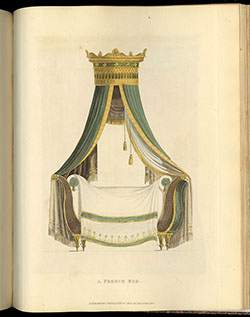 |
Augustus C. Pugin, Modern Furniture (London, 1823).
An architectural draughtsman, Augustus C. Pugin’s (1762-1832) skill as an illustrator is evident. He collaborated with publisher Rudolph Ackermann on several books, and many of these colorful plates came from the Repository magazine. Pugin included a number of elegant French beds draped in silk with lace and fringe. |
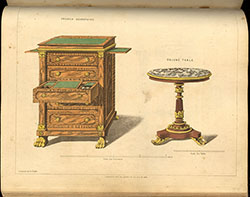 |
George Smith, The Cabinet-Maker and Upholsterer’s Guide (London, 1826).
Smith, inspired by Thomas Hope, introduced classical styles to a broader audience, and his publication was widely circulated in the United States. This French secretaire with compartments for combs, brushes, and other items for dressing, sits on lion’s paw feet, popular during this time. |
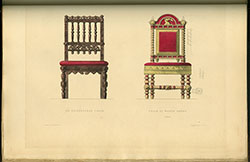 |
Richard Bridgens, Furniture with Candelabra and Interior Decoration (London, 1838).
Trained as a sculptor and furniture designer, Bridgens created designs that included styles admired in Britain at the time: Grecian, Gothic, and Elizabethan. These Elizabethan chairs embody stateliness and grandeur. |
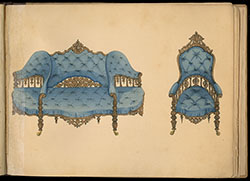
|
Henry Wood, A Useful and Modern Work on Settees, Sofas, Ottomans, and Easy Chairs (London, 1846). Bequest of James Rush, 1869.
Have a seat! This collection of thirty colored plates advertised Henry Wood’s creatively ornate, seated furniture. |